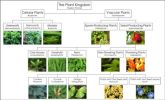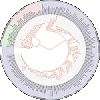Unless otherwise noted,
the material on this page may be used under the terms of a
Creative Commons License.
| Systematics | ||
| Life | Systematics |
| Home | Great Chain of Being | |
| Paleontology | Life | Ecology |
In order to make sense of the natural world, science creates categories and classification systems. In the case of living organisms, which include millions of species that evolved through several billions of years of Earth history, and whose characteristics (especially in the case of fossil species) and evolutionary relationships are often imperfectly understood, classification often becomes arbitrary. Add to this the fact that specialists working in different fields may have different approaches or preferences, and it is easy to see how the subject can become confusing, and ideas and methodologies have changed radically over time. MAK120229
Systematic Biology - Systematics for short - is the branch of biology that deals with classifying living beings: the diversity and interrelationships of living beings, both current organisms ("neontology") and ancient ones ("palaeontology"). It can be divided into three parts.
The protoscience and science of systematic biology has gone through at least six major shifts of worldview, from myth to modern science. The currently preferred system of phyogenetics will no doubt give way to further insights as knowledsge progresses.
In pre-modern and pre-scientific cultures, the world (including living organisms and inanimate objects) was classified according to the archetypal mandala - the four cardinal points, each associated with an element, a season, a deity, an animal, and so on, which constituted the underlying structure of the world (much as the elementary particles and forces in quantum physics is considered nowadays). This system of symbolic correspondences by association, which is metaphysical rather than scientific, reached great sophistication in the Chinese system of Five States of Change, the traditional Indian (Samkhyan and Tantric) doctrine of tattwas, and more recently (late 19th century) in Hermetic Kabbalah, as well as in "New Age" thought in general. Especially in China, the doctrine of universal correspondences, in association with the idea of a fundamental cosmic polaritry of yin and ying, developed into something very close to, but noit quite, experimental science (see Jacob Needham, Science and Civilisation in China).

A different slant on things was given by Aristotle, who introduced the idea of the scala naturae - the natural ladder. Like the yin-yang school of ancient and medieval China, this represented the beginning of a true science of the natural world. In later centuries, Aristotle's protoscience was subsumed under an elaborate system of metaphysics, according to which the natural world is interpreted in terms of the principle of plenitude, the overflowing abundance of the first principle or Godhead which creates successive beings. The further the beings are from the source the more ontologically impoverished they are. So you have formless matter right at the bottom, then rocks, plants, lower animals, higher animals, man, and finally spiritual and divine beings. This hierarchical view of the world - the Great Chain of Being [see Arthur Lovejoy's classic coverage of this topic], persisted through the middle ages and up until the scientific revolution of the seventeenth and eighteenth centuries, when it was replaced by a sort of monotheistic dualism - there is the material world or creation, and there is God in his heaven. With growing knowledge of the natural world it became impractical to organise everything in existence in a single linear series, and the orientating theme of a ladder of nature gave way to one of a tree of life

In the 18th century the Swedish botanist Carl von Linné, better known under the Latinized form of his name, Linnaeus, developed what's known as the binomial system of classification, in order to simplify the chaotic state of affairs around at his time. (Some plants were given names ten words long for example). He used Latin because that was the academic language of the time. Linnaeus adopted Great Chain of Being thinking in organising the natural world into three kingdoms, animal, vegetable, and mineral, although his division of each kingdom into class, . The modern system of classification in current widespread use is the binomial hierarchical system introduced by Linnaeus.
The Linnaean system is not a phylogeny, but a system of classifying the living world, developed at a time when species were considered immutablethe same today as when first created by an external God. We now know that species evolve but Linnaean taxonomy is such a useful and adaptable methodology that it has been taken up and become central to botany and zoology as a whole ever since.

While Linnaeus founded taxonomy and classification, it was left to Charles Darwin in the 19th century to introduce the theory of evolution and hence make possible phylogenetic reconstruction; that is, the evolutionary relationships and history of the various groups of organisms through geological time (millions of years). That's where things really get interesting, because life as a dynamic process is much more fascinating than life as a static series of unchanging types.
Evolutionary theory replaced the linear Ladder of Nature / Chain of being with a branching evolutionary tree of life. Even so, it took a while for the static linnaean classification to be fully incorporated within evolutionary theory. Evolutionary Systematics is the integration of the Linnaean system of taxonomy with mid-20th century Evolutionary Synthesis to form a dynamic system of classification. This establishmed the new science of Systematic Biology.

Cladistics - also called Phylogenetic Systematics or Phylogenetic Taxonomy - is a method of classifying organisms by common ancestry, developed by Willi Hennig, an entomologist, in 1950, but was not really accepted until the 1980s. Like Evolutionary Systematics (which it has currently supplanted) Cladistics is a method of classification based on the evolutionary history of organisms, dividing organisms into meaningful groups and subgroups. Based strictly on determining branching points in the ancestry of organisms, it establishes groups based on their shared, derived features (synapomorphies), while ignoring primitive features (plesiomorphies) inherited from ancestors. Organisms that share common ancestors (and therefore have similar features) are grouped into taxonomic groups called clades. Clades can be represented in terms of a cladogram. A cladogram is a branching tree-like diagram that depicts species divergence from hypothetical common ancestors. It shows the distribution and origins of shared characteristics.
Originally based only on morphological analysis of obvious synapomorphies, represented by a single branching tree (cladogram), cladistics quickly became a very popular tool in vertebrate paleontology, especially regarding the evolution of reptiles, a group with a rich fossil history, and of dinosaurs into birds. One of the important discoveries cladistics made was proof of the dinosaurian ancestry of birds (previously, birds were cderived from more generalised reptiles called thecodonts).
But organisms can also have share characteristics but have a different evolutionary (phylogentic) history. This is called homoplasy. One of the continuing challenges of Cladistics, and of rival and complementary systems like molecular phylogeny, is how to distinguish the "fake" synapomorphies (homoplasies) from the "genuine" ones (homologies).
Cladistics soon incorporated statistical analysis, resulting in a shift of emphasis and very different cladograms. Computational cladistics has not remained independent for long, as it was brought together with molecular phylogeny to form the science of Phylogenetics.

Molecular phylogeny traces phylogeny uses DNA, RNA, and protein molecular sequences. As with cladistics, molecular phylogenetic analysis results in a branching tree-like diagram, called a phylogram. Both molecular phylogenetics and computational cladistics use statistical analysis to build evolutionary trees, and the tendency now is to combine the two in a single integrated methodology, called computational phylogenetics. But this is not an equal partnership. Molecular analysis is universally privelaged over that of cladistic morpholological analysis whenever there is a contradiction between the two. This means the end of phemonic parsimony, and, very often (for example with mammal phylogeny) an absence of synapomorphies. Only when considering fossil forms alone is morphology-based cladistics still considered authoritative.

Phylogenetics is the name give to the integration of cladistics - especially computational cladistics - and molecular phylogeny. A phylogenetic study may be based just on cladistics on its own, on molecular phylogeny alone, or, increasingly now, the combination of the two, with cladograms that include both morphological (phenomic) and molecular data. It is hoped in this way to resolve the numerous phylogenetic incongruences between morphology and molecular-based studies.
It is hoped the reader will excuse the following rant on the unnecessary self-restrictions of normal (kuhnian) science as applied to systematic biology
The present author (MAK) has noted the tendency, in the history of evolutionary thinking, for each paradigm to replace the preceding one not because the earlier paradigm was refuted, but because the newer one has become more fashionable. Thus Cladistics replaced Evolutionary Systematics in the 1980s and 90s, even though the two use different methodologies and even different data. Evolutionary Systematics deals with problems of geographic isolation, speciation, ancestral taxa, stratigraphy, and large scale (supra-species) lineages. Cladistics uses a highly formalistic approach in order to test different evolutionary trees and arrive at the most likely phylogenetic hypothesis. Why then did evolutionary systematics fall from grace? The reason generally given, and the advantage cladistics has, is that it provides a more quantitative methodology (the same can be said for cladistics early and short-lived rival phenetics).
Although the two methodologies are equally robust, several reasons have been given why molecular phylogeny should be considered more reliable than phenomic morphology, such as larger and easily quantifiable strings of data, and the fact that many DNA sequences are invisible to natural selection and hence would give a more reliable phylogenetic signal. For example, some DNA codes have synonymous effects, e.g. they may code the same amino acid, or if diplicated or "junk" DNA sequences they may never be read at all (Dawkins, 2004, p.132). Yet conversely, the fact that there are only four types of RNA/DNA necleotide bases in every genome makes the problem of homoplasy far worse, and this can only be countered by even more statistical analysis. The premise that molecular phylogeny is more reliable than morphology-based cladistics has almost never been challenged (one of the very few criticisms, by former Palaeos author ATW, here). And while there are certainly advantages in quantification in that it makes computational phylogeny easier, that doesn't mean that Nature herself must work that way. One is reminded of the Mulla Nasrudin story (by popular Sufi author Idries Shah) about the man who lost his keys in his house, but searched for them under the lamp-post, because there was more light there.
All in all, newer taxonomic and phylogenetic methodologies are not necessarily the most inclusive. The newer and older may simply present equally valid but totally opposite methodologies, as regards for example taxonomic rating determined either by diversity or branching sequence, or the contrast between qualitative and quantitative/statistical approaches. The earlier system may be more inconclusive than the later, as for example when evolutionary systematics recognises all three types of speciation, which means it is able to deal with well-sampled groups such as some foraminiferan or ammonite sequences, Neogene molluscs, or Cenozoic and especially plio-pleistocene mammals, whereas cladistics does better with poorly known groyups, and it is usually assumed (see above paragraph) in phylogenetics that molecular phylogeny is better with neontological groups. From this perspective one realises how absurd it is to claim that only one system is the true one for every situation.
MAK130331
Taxonomy: Classifying Life - John Kimball - excellent overview (part of Kimball's Biology Pages).
Taxonomy, Transitional Forms, and the Fossil Record - Keith B. Miller - online essay, makes some interesting observations.
| Great Chain of Being |